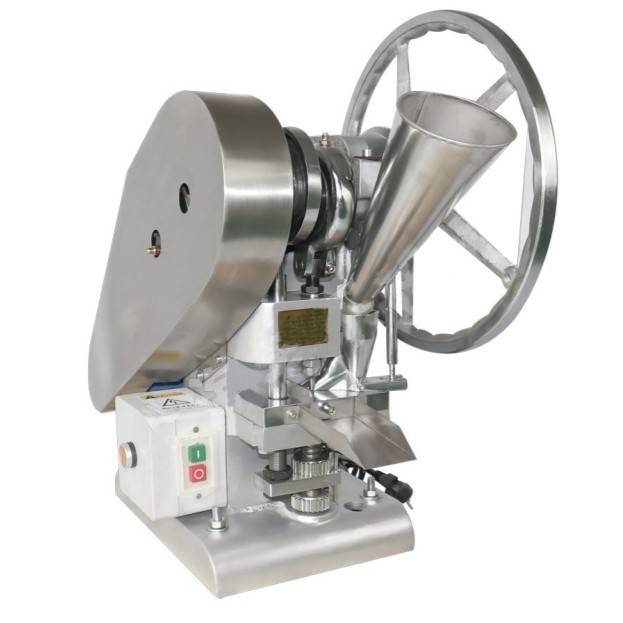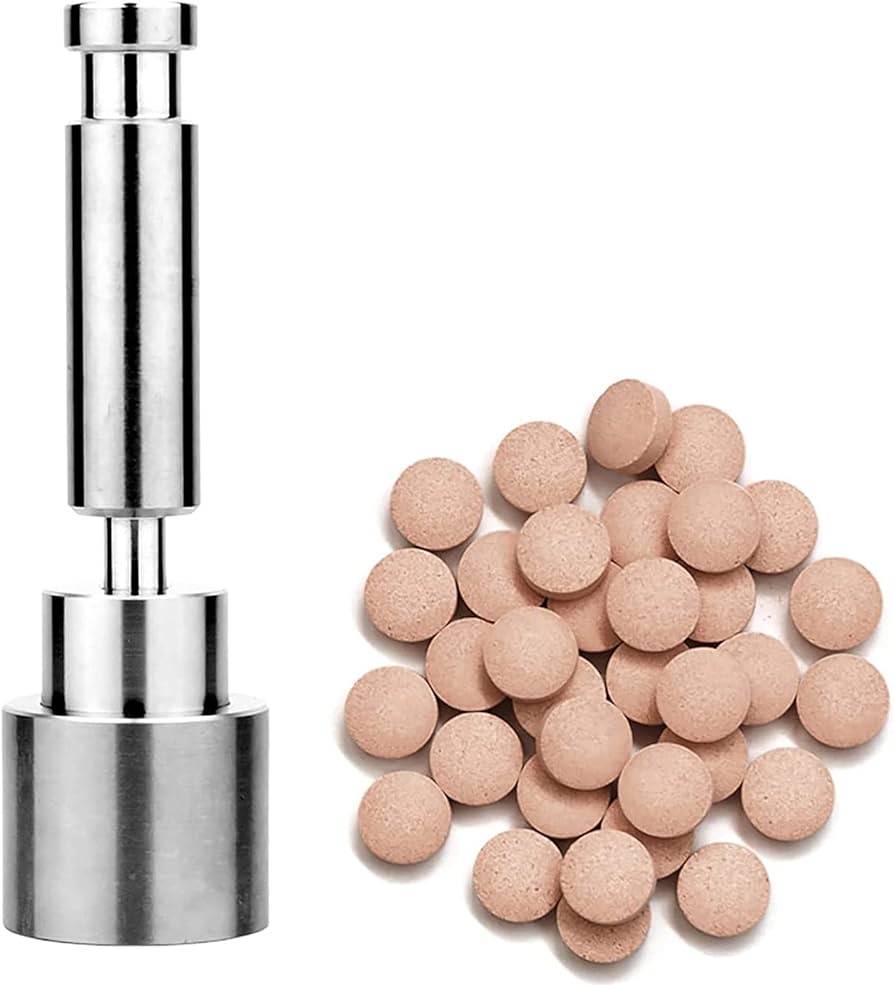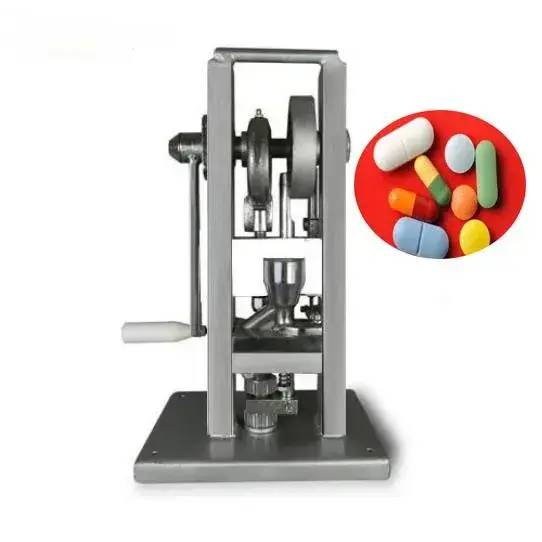Comparison with Rotary Tablet Presses

Single Punch Tablet Presses
Single punch presses are composed of several parts, including the hopper, die cavity, punches, dosing plow, and ejection cam. These presses are best suited for projects with small amounts of test material and when the user is looking to confirm compressibility. The advantages of single punch presses include their small size, ease of operation, low noise levels, and the ability to test the feasibility of compression.
Rotary Tablet Presses
Rotary tablet presses have a significantly greater number of parts compared to single punch presses. In addition to the hopper, die cavity, upper and lower cam tracks, and punches, these presses also contain a discharge chute. Rotary tablet presses are ideal for applications requiring high batch production due to their ability to provide significant output and precise control. Some advantages of rotary tablet presses include the ability to independently control the weight, thickness, and hardness of tablets when equipped with available peripheral devices.
Both single punch tablet presses and rotary tablet presses are efficient in producing tablets. However, the method of compression varies slightly between the two types of presses. Single punch presses compress the powder mixture using a single punch, while rotary tablet presses use multiple punches to compress the powder mixture.
One important aspect to consider when choosing a tablet press is maintenance cost and durability. Both types of presses have their own advantages and disadvantages in this regard. Rotary tablet presses are typically made using advanced manufacturing processes and materials, resulting in high durability and low maintenance costs. On the other hand, single punch presses have relatively simple structures and lower maintenance costs, but may experience wear and corrosion issues over time.
In summary, electric tablet presses and traditional manual tablet presses each have their own advantages and disadvantages. Electric tablet presses offer advantages in terms of work efficiency, production capacity, pressing quality, and safety, making them suitable for large-scale production. Manual tablet presses are easier to operate and have lower maintenance costs, making them suitable for small-scale production and laboratory use.
Kintek offers a range of tablet press models, including the TPM-series, i-series, and P-series, to cater to different needs. These models are known for their high quality, efficiency, and precision.
Pressure Control and Regulation
In the world of tablet manufacturing, manual tablet presses play a crucial role in producing high-quality tablets. These presses are equipped with pressure control mechanisms that allow operators to adjust the amount and timing of compression. The ability to regulate pressure during the tabletting process is essential in ensuring the desired tablet quality.
Components of a Manual Tablet Press
Before diving into pressure control and regulation, it's important to understand the various components of a manual tablet press. In addition to the essential parts like the hopper, die cavity, upper and lower cam tracks, and punches, manual tablet presses also feature some additional components that contribute to the precise tablet compression technique.
-
Feeder System: The feeder system is a vital part of the compression process. It distributes the product from the hopper into the die cavities, over-filling them prior to more precise control by the dosing station. The feeder system consists of an exterior housing, rotating interior paddle wheels for product distribution, and a base plate.
-
Fill Cams and Dosing Station: The fill cams and dosing station work together to control the precise amount of product fed into the die cavities before compression. This determines the weight of the tablets.
-
Pre-Compression Rollers: Pre-compression rollers provide initial compression to remove any air trapped within the die cavity. This step ensures uniform tablet density and eliminates any potential air pockets.
Importance of High-Quality Tooling
To achieve consistent tablet quality, it is crucial to use high-quality tooling in the manual tablet press. Parts like punches and dies have a direct impact on the size, shape, appearance, weight, thickness, and hardness of the tablets. When these wear parts need replacement, using high-quality replacements is vital to maintain the long-term efficacy and life expectancy of the tablet press.
Investing in good preventive maintenance programs and ensuring the use of high-quality tooling can significantly enhance tablet quality and reduce downtime due to tooling issues.
Pressure Control Mechanisms
Manual tablet presses are equipped with pressure gauges and pressure regulation mechanisms to provide control over the compression process. These features allow operators to adjust the amount and time of pressure applied during tablet compression. The pressure regulator plays a crucial role in controlling the tablet press's pressure, and the pressure regulating mechanism adjusts the tightness of the tablet based on the nature and requirements of the drug being compressed.
By controlling the movement of the punch and adjusting the distance between the dies, a manual tablet press can press drugs or powdery materials into tablets. The pressure control mechanism ensures that the tablets are compressed with the right amount of force, resulting in consistent tablet quality.
Conclusion
Manual tablet presses equipped with pressure control mechanisms are essential in the manufacturing process of high-quality tablets. The ability to regulate pressure during compression allows for precise control over tablet weight, thickness, and hardness. By using high-quality tooling and implementing proper maintenance programs, manufacturers can ensure the long-term efficacy of their tablet presses. With the right pressure control and regulation, operators can consistently produce tablets of superior quality.
Working Principle of Lab Single Punch Tablet Press

A lab single punch tablet press is a machine used for the development and small-scale production of tablets in the pharmaceutical, chemical, food, and metallurgy industries. It operates by pressing drugs or other powdery materials into tablets with precise control over the movement of the punches and the applied pressure.
Pressure Control
Manual tablet presses are typically equipped with pressure gauges, allowing the operator to control the amount and duration of pressure during the compression process. The pressure regulating mechanism adjusts the tightness of the tablet according to the nature and requirements of the drug. This manual control ensures that the tablets are compressed to the desired density and hardness.
One-Way Tablet Press Principle
The working principle of a lab single punch tablet press is based on a one-way tablet press mechanism. In this mechanism, the lower punch remains fixed, while only the upper punch moves to apply pressure. This one-way motion allows for efficient and controlled tablet formation. The upper punch exerts the entirety of the compression force to create the tablets.
Structure and Movement of Punches
A lab single punch tablet press consists of a pair of upper and lower punches and a die. The die is a hollow cylindrical cavity that shapes the tablet. The lower punch remains stationary, providing a solid base for tablet compression. The upper punch moves in a controlled manner, descending into the die cavity to compress the powder and form the tablet.
Role of the Turntable
In a rotary tablet press, there are multiple tooling stations installed on a rotating turret. However, in a lab single punch tablet press, there is no turntable involved. The focus is on developing tablets on a small scale, and the manual operation of the single punch press allows for precise control and flexibility in the tablet production process.
Tablet Compression Process
The tablet compression process in a lab single punch tablet press involves several steps. First, the powder or granular material is filled into the die cavity. The upper punch then descends under pressure, compressing the powder to form a tablet. Once the compression is complete, the lower punch remains stationary while the upper punch retracts. The tablet is then ejected from the die cavity, making way for the next cycle of tablet production.
Advantages of Lab Single Punch Tablet Press
The lab single punch tablet press offers several advantages in research and development applications. This type of tablet press is particularly suitable for projects involving small amounts of test material and when the user needs to confirm compressibility. Here are the key advantages of using a lab single punch tablet press:

Small Size
One of the main advantages of the lab single punch tablet press is its small size. This compact design makes it easy to fit into a laboratory setting, where space is often limited. Moreover, the small size allows for easy transportation and storage, making it convenient for research and development projects that require mobility.
Ease of Operation
The lab single punch tablet press is designed to be user-friendly and easy to operate. It typically features intuitive controls and a simple setup process, which makes it ideal for researchers and technicians who are not necessarily experts in tablet press operation. This ease of use enables efficient workflow and minimizes the time spent on training and troubleshooting.
Low Noise Levels
In a laboratory environment, where precision and concentration are crucial, noise can be a significant factor. The lab single punch tablet press is designed to operate quietly, minimizing disturbances in the workspace. This low noise level ensures a more comfortable working environment and allows researchers to focus on their experiments without distraction.
Compression Feasibility
The lab single punch tablet press provides compression feasibility for research and development purposes. It allows users to test the compressibility of different materials and evaluate the quality of the tablets produced. This feasibility is particularly important in the early stages of pharmaceutical development, where researchers need to assess various formulations and determine their suitability for large-scale production.
The lab single punch tablet press, also known as an eccentric or single-station press, is a simple form of tablet press. It consists of a single station of tooling, which includes a pair of upper and lower punches and a die. The lower punch remains stationary, while the upper punch exerts compression force to create tablets. This stamping process enables researchers to produce tablets and evaluate their properties efficiently.
In summary, the lab single punch tablet press offers several advantages for research and development applications. Its small size, ease of operation, low noise levels, and compression feasibility make it an excellent choice for projects involving minimal amounts of test material and the need to confirm compressibility. With its capabilities, this type of tablet press facilitates efficient tablet production and evaluation in the laboratory setting.
Features of laboratory punch tablet
Lab single punch tablet press machines are widely used in various industries such as pharmacy, chemical, food, and metallurgy. These machines play a crucial role in both research and development as well as small-scale production. Here, we will explore the different applications and working process of lab scale mini tablet press machines.
Ability to Independently Control Weight, Thickness, and Hardness of Tablets
Lab tablet presses equipped with available peripheral devices offer the ability to independently control the weight, thickness, and hardness of tablets. This feature allows researchers and manufacturers to have precise control over the characteristics of the tablets they produce. By adjusting the settings of the tablet press, they can create tablets that meet specific requirements and standards.
Production Capacity
Lab tablet presses are capable of producing a high number of tablets per hour, depending on the press size and tooling configurations. These machines can produce up to 1,000,000+ tablets per hour, making them efficient for small-scale production. The production capacity can be optimized by selecting the appropriate press size and tooling configurations based on the specific requirements of the application.
Precise Control and Management of Filling
Lab tablet presses feature an induced feeder that allows for precise control and management of the filling of the die cavities. This ensures that the tablets are consistently filled to the desired level, resulting in uniform tablet quality throughout the production process. The induced feeder mechanism enables researchers and manufacturers to achieve accurate and reproducible tablet weights.
Interface Capability with In-House Network Systems

Lab tablet presses can be integrated with in-house network systems, enabling remote monitoring and data archiving. This feature facilitates real-time monitoring of the tablet press operation, allowing researchers and manufacturers to track the production process and make any necessary adjustments. The ability to store and analyze data also provides valuable insights for process optimization and quality control.
Cost Efficiency
Lab tablet presses offer greater cost efficiency compared to single punch presses. They provide advanced features and functionalities that streamline the tablet production process, resulting in higher productivity and reduced production costs. The ability to control tablet weight, thickness, and hardness independently ensures minimal wastage of materials, further enhancing cost efficiency.
Wide Range of Applications
Lab tablet presses, particularly rotary presses, are versatile and can meet most tablet batch requirements in various industries. They are commonly used in pharmaceutical, nutraceutical, confectionery, and veterinary applications. Additionally, they are also utilized in the production of catalysts, ceramics, powdered metals, and other compressible materials.
Conclusion
In conclusion, the lab single punch tablet press is a valuable tool in the laboratory setting, particularly for research and development purposes and small batch production. Its basic working principle, which involves the movement of punches, die structure, and the turntable, allows for precise and efficient tablet compression. Compared to rotary tablet presses, the lab single punch tablet press offers advantages such as small size, ease of operation, low noise levels, and compression feasibility. It is widely used in various industries, including pharmacy, chemical, food, and metallurgy. With features like high precision filling, low material consumption, and smooth operation, this machine is an ideal choice for laboratories seeking reliable tablet compression solutions.
Related Products
- Single Punch Electric Tablet Press Machine Laboratory Powder Tablet Punching TDP Tablet Press
- Single Punch Electric Tablet Press Machine TDP Tablet Punching Machine
- Lab Scale Rotary Single Punch Tablet Press Machine TDP Tablet Punching Machine
- Single Punch Tablet Press Machine and Mass Production Rotary Tablet Punching Machine for TDP
- Multi-Punch Rotary Tablet Press Mold Ring for Rotating Oval and Square Molds
Related Articles
- In-depth Analysis of Tablet Press Machine R&D Lab Model (1)
- The working process of the tablet press you should know
- Fully automatic tablet press operating steps and replacement accessories
- Understanding the Tablet Press Machine R&D Lab Model and its Features(2)
- Sample preparation and unloading method of electric tablet press












